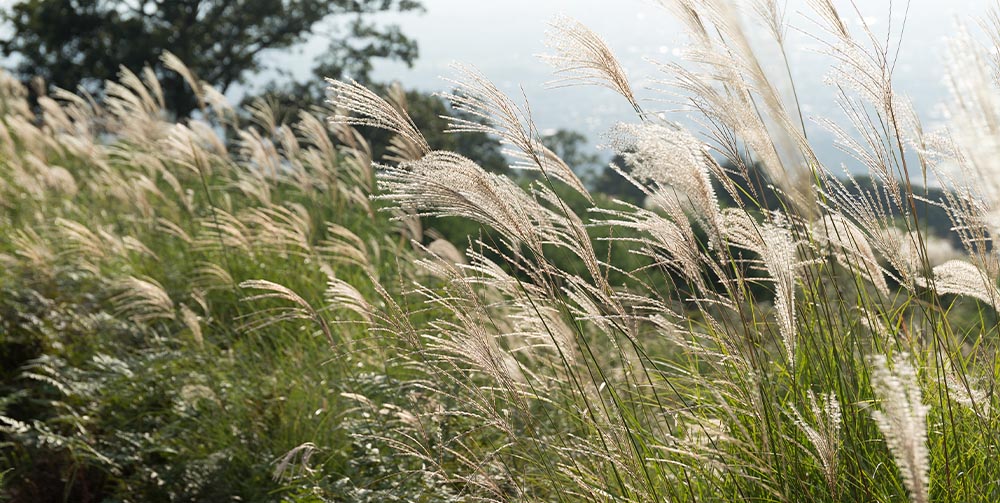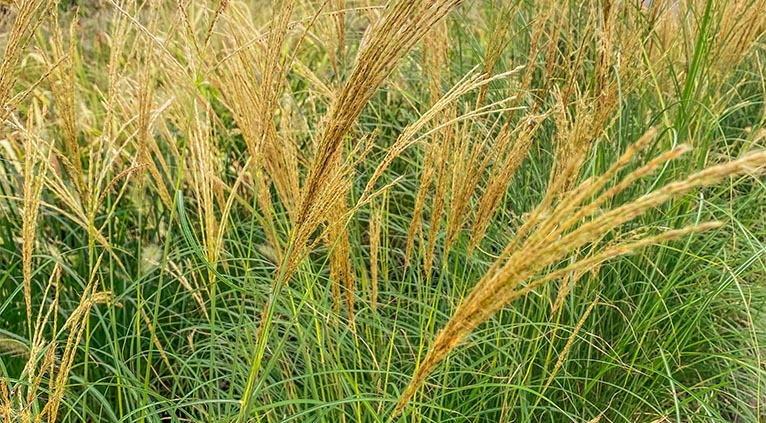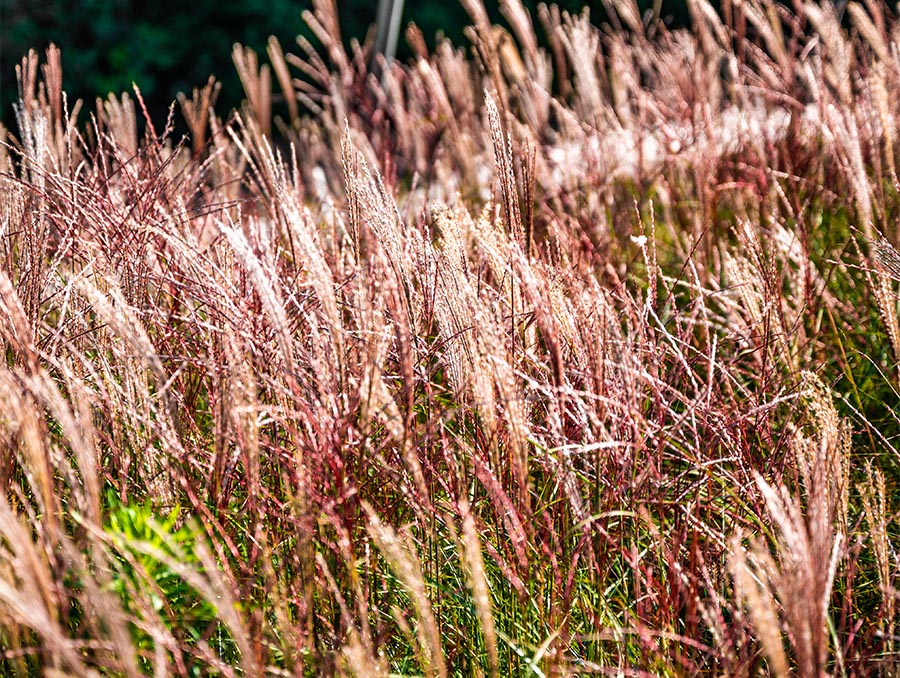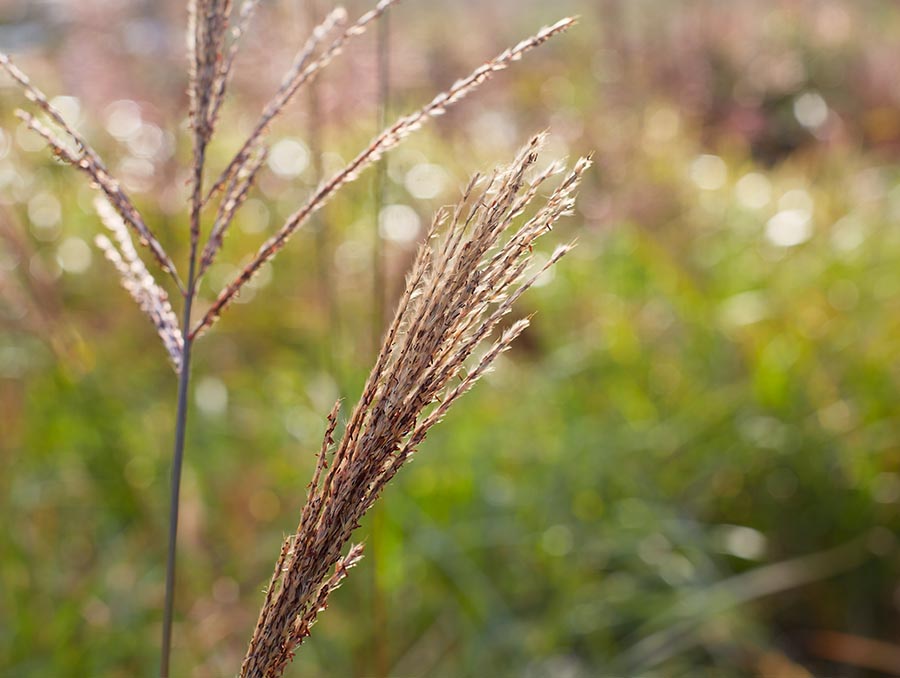Plant Focus: Miscanthus sinensis
A tall grass with feathery flowers in late summer.
Miscanthus sinensis, often known as Chinese silver grass or eulalia grass, is native to Japan, Korea, and China and flourishes in lowlands and lower alpine regions. It is commonly used as an ornamental grass in landscaping due to its striking appearance and low maintenance. The grass adds height and movement to mixed borders and is complimented by colourful perennials in a prairie-style planting scheme.
Notably, the seed heads of Miscanthus provide visual interest while serving as a food source for birds. This supports local biodiversity by attracting a varied range of bird species, which helps to maintain a healthy ecosystem. Not only is it enjoyable to see birds in our gardens and green spaces, as a way of feeling closer to nature, but we also benefit from their role of biological pest control, as they feed on invertebrates, like caterpillars, aphids and snails, that damage our plants.
Miscanthus produces the best results when planted in a well-drained area during spring or autumn. Miscanthus flower from late summer through to autumn, adding an extra touch of elegance to the landscape during this transitional season.
The graceful, feathery seed heads usually form in late summer to early autumn and can last well into the winter months, Looking beautiful with a dusting of frost. These seed heads naturally release their seeds as they mature, and seed distribution is often aided by the wind.
Key Characteristics of Miscanthus:
✓ Deciduous perennial
✓ Height varies from 1m to 1.5m
✓ Prefers full sun
✓ Low maintenance
✓ Grows well in most soils
✓ Ideal planted in borders or in raised planters
✓ Known for its durability, with the ability to withstand various climates, soils, and conditions once established.

Different Varieties Of Miscanthus sinensis

Miscanthus sinensis ‘Gracillimus’
Miscanthus sinensis ‘Gracillimus’
This deciduous grass features the narrow, arching leaves with white midribs, commonly known as eulalia ‘Gracillimus’, complimented by clusters of purple-tinged flower heads that bloom in late summer and fade to silver in winter. ‘Gracillimus’ typically reaches a height of 1.5m, adding vertical interest to the landscape.
Miscanthus sinensis ‘Kleine Fontäne’
A compact deciduous grass, that reaches a height of up to 1.5m tall. It features narrow, white foliage that turns yellow in the autumn season. In late summer, the grass showcases feathery red flower heads that gradually transition to a silver hue.
Miscanthus sinensis ‘Morning Light’
A compact and elegant grass with narrow, white-edged leaves, Miscanthus sinensis ‘Morning Light’ brings elegance to any landscape. It reaches a height of around 1.2m, and in autumn, it forms clusters of pink-tinged flowers. This variety can be planted as a specimen in a container.
Miscanthus sinensis ‘Kleine Silberspinne’
This compact and shorter variety of Miscanthus features narrow foliage with the distinctive reddish flower heads. It reaches a height of 1.2m in late summer, and as the season progresses, the flower heads turn a pale brown hue, remaining attractive well into the winter months.

Miscanthus sinensis ‘Kleine Silberspinne’
Miscanthus sinensis ‘Yakushima Dwarf’
This compact, deciduous grass is distinguished by gracefully arching, fine-textured foliage which form dense clusters, making it an excellent choice for small gardens, borders, or container plants. As the name suggests, this variety is shorter and grows to a height of approximately 1m. During autumn, its feathery flower heads turn to a pale brown colour.
Miscanthus sinensis ‘Zebrinus’
A deciduous grass that grows to a height of 1.5m and is characterised by its arching, linear leaves that feature horizontal bands of cream or pale yellow. Miscanthus sinensis ‘Zebrinus’ is given the name ‘zebra grass’ for its distinctive foliage, which adds an interesting pattern to a mixed border and works well in a tropical planting scheme.

Miscanthus sinensis ‘Zebrinus’
Fun Fact
Miscanthus is planted as an agricultural crop – grown as a biofuel or as a cover crop for game birds. It is a carbon negative crop – the root rhizomes sequester at least net 0.64 tonnes of carbon (2.35 tonnes CO2e) per hectare, per year into the soil
How to grow and care for Miscanthus Sinensis
Miscanthus sinsensis requires minimal pruning and care. It is drought-tolerant, eliminating the need for watering once established. Trimming dead leaves when winter gives way to spring encourages fresh growth at the base of the plant. When the clumps get overcrowded, separate them in early spring to reinvigorate their growth. Use a spade to lift each grass then divide the clumps by inserting two garden forks back-to-back into the plant’s crown and gently pull the handles down. A mattock or knife might be needed to split tough root balls. These newly created clumps can then be replanted in new beds.
Miscanthus flower best during a hot, sunny period, therefore poor flowers could be the result of a cool summer. A wet winter might cause plants to rot, if you are working with heavy clay soil, you can try to mitigate this by putting some horticultural grit into the planting hole before planting. Very intense, hot sun can produce brown areas on variegated Miscanthus varieties. If there is browning around the edges of variegated leaves, this could be a form of rust, and you should remove the affected leaves as soon as possible to ensure the plant stays in prime condition.
Pests and diseases that affect this species
Miscanthus are generally trouble free but are susceptible to a variety of leaf spotting fungi. Miscanthus Blight is a more common disease for these plants caused by the Stagonospora fungus. This can cause purplish or rust-coloured dots and streaks on the leaves, which are quite obvious to the naked eye, especially on the white areas of variegated leaves. To treat this disease, trim out the damaged foliage and safely dispose of the cuttings to avoid the disease spreading.
If you would like more information on the Miscanthus sinensis varieties which we grow and supply, get in touch with the G Team today.

